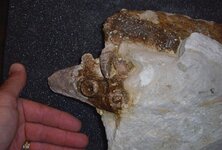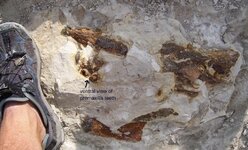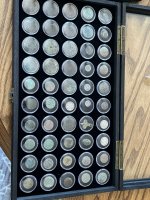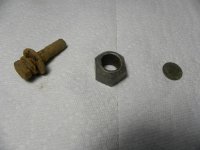You are using an out of date browser. It may not display this or other websites correctly.
You should upgrade or use an alternative browser.
You should upgrade or use an alternative browser.
Anarchaeology
- Thread starter uniface
- Start date
naturegirl
Bronze Member
- Mar 21, 2009
- 2,356
- 402
It is interesting, but still I remain skeptical. Which surprises me. I can absolutely believe european, or south americans were here, looonnng time ago. I have no problem understanding there is so much more to human travels and humans populating the world, than what I was taught in grade school. But the whole "mysterious" nature of this article have me thinking someone, the Campbells, are exploiting Americans seeming need for conspiracy. If they found an "unknown" mineral, or sustance, why didn't they just bring some of it home to be analyzed? And a pile of paleolithics in a spot where they had seen a grinning man standing? Those type of statements really give me pause.
For me, this points out how valuable archeology is, professional excavation and evaluation is, and further underscores my belief that we will never find truthful answers, because we just can't get along.
Thanks for posting these uniface , it's in my backyard, I will be keeping my eyes open! And my heart, and mind also.
, it's in my backyard, I will be keeping my eyes open! And my heart, and mind also.
resectfully,
naturegirl
For me, this points out how valuable archeology is, professional excavation and evaluation is, and further underscores my belief that we will never find truthful answers, because we just can't get along.

Thanks for posting these uniface
resectfully,
naturegirl
Tylocidaris
Jr. Member
Naturegirl,
You have a healthy skepticism, and it is warranted regarding the Rockwall information provided in the link. The beauty of the local geology is responsible for the unaltered patterns in the photos that are not contextually cropped. The Upper Cretaceous marls of the Rockwall area are famous for their shrink / swell patterns. This creates the stone and mortar look in the photos. You can see this in these geologic formations from Rockwall to Austin and San Antonio. These same patterns are visible in road cuts that slice through the Austin and Taylor Group formations.
They also are subject to a lot of local faulting that is sometimes filled with calcite as a result of geochemical processes. As the softer clay/shale erodes away, the resistant calcite "dikes" are often left behind. In addition, the "iron rings" are where large pyrite nodules have weathered out of rock on their way to limonite or hematite. Again, these are very common. It's hard to place much credibility in someone's conclusions that overlooked a rather simple geologic identification. Especially, since it is a "headlined" photo for The Quivira Project. These are very common features to anyone that spends a lot of time in these Upper Cretaceous formations.
However, the most amazing oversight is the alleged "effigy" found by Dr. Glenn. This is the photo from the website:
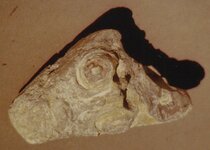
THIS IS A FOSSIL! It is also a testament to the lack of simple research required before making fantastic claims. What Dr. Glenn found is not an effigy, but a premaxilla of an 80 million year old swimming reptile, called a Mosasaur. In short, he found the tip of the snout to (most likely) a Tylosaurus species of Mosasaur!
I do spend a lot of time in these geologic formations, and 2 summers ago, I found most of the skull of the same type of mosasaur in Central Texas. Below are some photos of my find that show the premaxilla.
Folklore is still with us...now it's digital Something I've learned the hard way is that Fantastic claims require Fantastic Proof. You can research any of my statements above.
You have a healthy skepticism, and it is warranted regarding the Rockwall information provided in the link. The beauty of the local geology is responsible for the unaltered patterns in the photos that are not contextually cropped. The Upper Cretaceous marls of the Rockwall area are famous for their shrink / swell patterns. This creates the stone and mortar look in the photos. You can see this in these geologic formations from Rockwall to Austin and San Antonio. These same patterns are visible in road cuts that slice through the Austin and Taylor Group formations.
They also are subject to a lot of local faulting that is sometimes filled with calcite as a result of geochemical processes. As the softer clay/shale erodes away, the resistant calcite "dikes" are often left behind. In addition, the "iron rings" are where large pyrite nodules have weathered out of rock on their way to limonite or hematite. Again, these are very common. It's hard to place much credibility in someone's conclusions that overlooked a rather simple geologic identification. Especially, since it is a "headlined" photo for The Quivira Project. These are very common features to anyone that spends a lot of time in these Upper Cretaceous formations.
However, the most amazing oversight is the alleged "effigy" found by Dr. Glenn. This is the photo from the website:

THIS IS A FOSSIL! It is also a testament to the lack of simple research required before making fantastic claims. What Dr. Glenn found is not an effigy, but a premaxilla of an 80 million year old swimming reptile, called a Mosasaur. In short, he found the tip of the snout to (most likely) a Tylosaurus species of Mosasaur!
I do spend a lot of time in these geologic formations, and 2 summers ago, I found most of the skull of the same type of mosasaur in Central Texas. Below are some photos of my find that show the premaxilla.
Folklore is still with us...now it's digital Something I've learned the hard way is that Fantastic claims require Fantastic Proof. You can research any of my statements above.

Attachments
naturegirl
Bronze Member
- Mar 21, 2009
- 2,356
- 402
thank you for the information Tylocidaris, especially about the formation of rocks, that gives me a palce to start reading about what i'm finding. Northern Ok is not so far away, I know I've seen something similar, just can't remember where.
thanks again,
ng
thanks again,
ng
Users who are viewing this thread
Total: 2 (members: 0, guests: 2)


